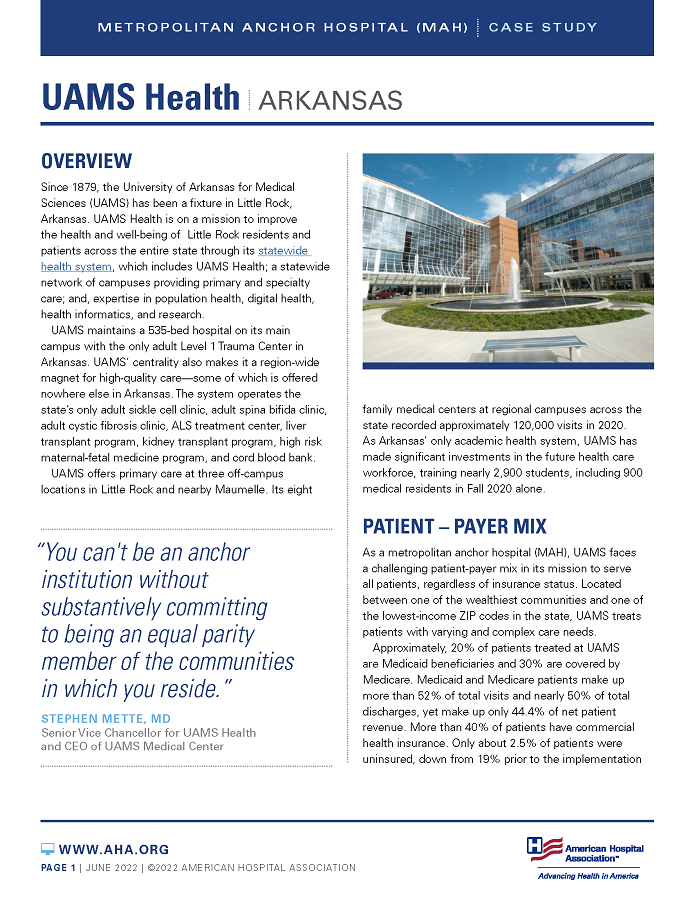

UAMS Health | Arkansas
Metropolitan Anchor Hospital (MAH) | Case Study
Overview
 Since 1879, the University of Arkansas for Medical Sciences (UAMS) has been a fixture in Little Rock, Arkansas. UAMS Health is on a mission to improve the health and well-being of Little Rock residents and patients across the entire state through its statewide health system, which includes UAMS Health; a statewide network of campuses providing primary and specialty care; and, expertise in population health, digital health, health informatics, and research.
Since 1879, the University of Arkansas for Medical Sciences (UAMS) has been a fixture in Little Rock, Arkansas. UAMS Health is on a mission to improve the health and well-being of Little Rock residents and patients across the entire state through its statewide health system, which includes UAMS Health; a statewide network of campuses providing primary and specialty care; and, expertise in population health, digital health, health informatics, and research.
UAMS maintains a 535-bed hospital on its main campus with the only adult Level 1 Trauma Center in Arkansas. UAMS’ centrality also makes it a region-wide magnet for high-quality care—some of which is offered nowhere else in Arkansas. The system operates the state’s only adult sickle cell clinic, adult spina bifida clinic, adult cystic fibrosis clinic, ALS treatment center, liver transplant program, kidney transplant program, high risk maternal-fetal medicine program, and cord blood bank.
UAMS offers primary care at three off-campus locations in Little Rock and nearby Maumelle. Its eight family medical centers at regional campuses across the state recorded approximately 120,000 visits in 2020. As Arkansas’ only academic health system, UAMS has made significant investments in the future health care workforce, training nearly 2,900 students, including 900 medical residents in Fall 2020 alone.
“You can't be an anchor institution without substantively committing to being an equal parity member of the communities in which you reside.”
Stephen Mette, MD
Senior Vice Chancellor for UAMS Health and CEO of UAMS Medical Center
Patient–Payer Mix
As a metropolitan anchor hospital (MAH), UAMS faces a challenging patient-payer mix in its mission to serve all patients, regardless of insurance status. Located between one of the wealthiest communities and one of the lowest-income ZIP codes in the state, UAMS treats patients with varying and complex care needs.
Approximately, 20% of patients treated at UAMS are Medicaid beneficiaries and 30% are covered by Medicare. Medicaid and Medicare patients make up more than 52% of total visits and nearly 50% of total discharges, yet make up only 44.4% of net patient revenue. More than 40% of patients have commercial health insurance. Only about 2.5% of patients were uninsured, down from 19% prior to the implementation of the Affordable Care Act. UAMS provides an average of more than $81 million in charity and uncompensated care annually.
UAMS is proud to serve a diverse group of patients. Approximately 15% of admissions are patients transferring from other hospitals seeking high-quality, specialty care.
An Institution Anchored to Its Community
Meeting the Unique Needs of All Local Communities
The main campus of UAMS services a variety of different communities with various needs, all of which UAMS is able to meet, demonstrating its role as a true anchor to the community. To the north lie several affluent neighborhoods whose residents receive primary care from other providers but depend on UAMS Health for specialty and emergency services. South of the campus, across the highway, are several neighborhoods that have no grocery stores, pharmacies, or banks. UAMS knows that these communities have different needs and face different social determinants of health (SDOH), which is why it collects SDOH information from every patient at the point of care. Understanding that a variety of factors such as household income, exposure to violence, and food security impact patient health helps UAMS’ medical providers address health inequities.
Recognizing the need to be a trusted member of the community, UAMS partners with several community organizations to bring health care and social services to traditionally marginalized areas. For example, a partnership to establish a healthy grocery store is underway. This commitment to equity also extends to supporting the UAMS workforce, especially those who come from low-income communities. The health system recently committed to paying a living wage for all employees, and through a partnership with local banks, builders, and the City of Little Rock, UAMS is working to rehabilitate old homes and provide low-interest loans to employees to purchase them.
Training Future Health Care Professionals – and Educating About Health Equity
UAMS plays an enormous role in educating Arkansas’ health care workforce, producing nearly half of the state’s practicing physicians. This commitment extends far beyond the Little Rock area. In rural areas of the state, which often face a shortage of doctors, UAMS trains an even higher percentage of physicians—nearly 60%.
A significant part of the curriculum includes mandatory training education around health equity and social determinants of health. UAMS staff are also required to attend educational seminars on intrinsic bias and health disparities, and they have the opportunity to volunteer with the health system’s clinics that provide free care in low-income communities.
Metropolitan Anchor Hospitals Need Greater Support
Like many other metropolitan anchor hospitals, UAMS faces serious financial pressures. Without stable financial support, the specialized programs and extensive community outreach activities that benefit the Little Rock community will be at risk. With a MAH designation and adequate funding, systems like UAMS would have the opportunity to ensure financial stability. Federal policymakers must do more to ensure systems like UAMS are able to obtain sustained, adequate support so their leadership can plan for the future and build upon their many successes.


